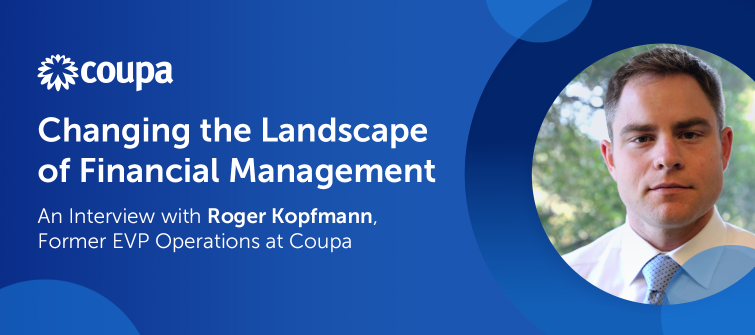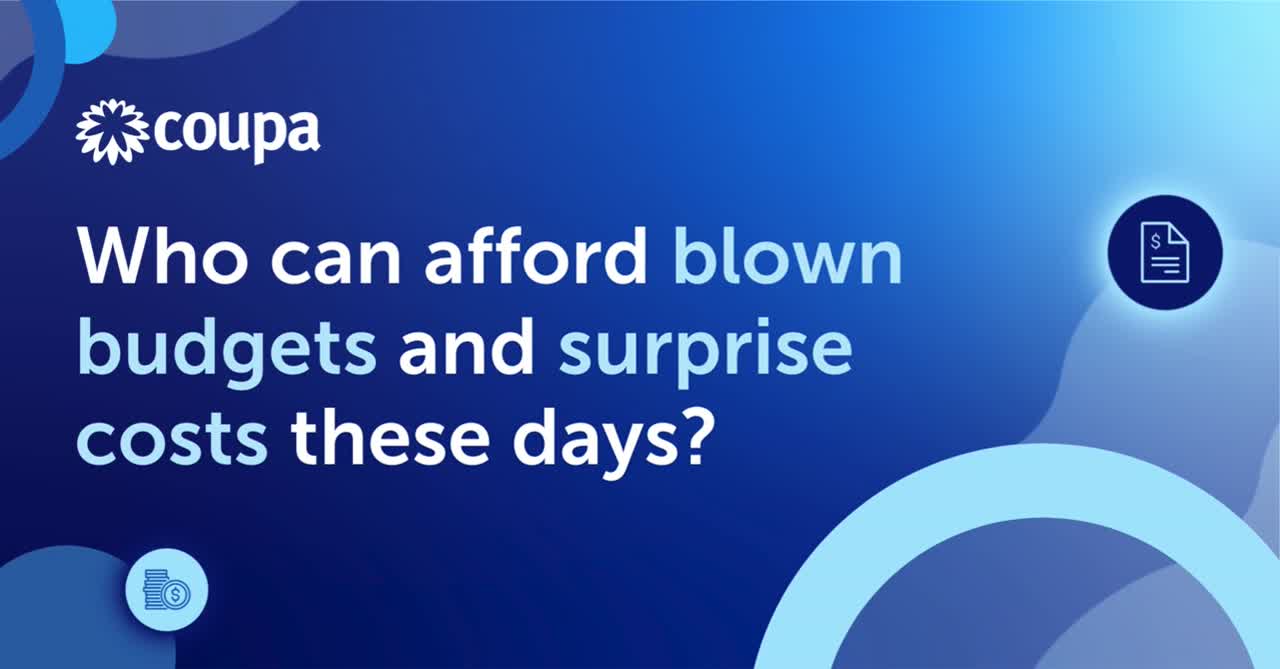Changing the Landscape of Financial Management: An Interview with Roger Kopfmann, Former EVP Operations at Coupa

Originally Published July 6, 2023 — Updated November 22, 2023.
Why do today’s economic challenges put such a strain on established FP&A processes? How does that affect how a company deploys and conserves cash? Is there a smarter way to operate? And just how is a Business Spend Management (BSM) platform like a car’s transmission? I sat down with Roger Kopfmann to find out. He is the former Executive Vice President, Operations for Coupa and drives the company's financial plan and many facets of its business execution. With over a decade at Coupa, Roger supports the FP&A, Business Operations, IT, and M&A Integration teams.
The changing macroenvironment and the need for agile financial management
Q. We’ve been having a lot of conversations with our customers about what’s changed in the macroenvironment since the pandemic and how, if at all, things will return to the way they were. What’s your take?
A. Well, I think that the speed at which information flows will continue to accelerate. And I definitely didn't have ‘bank failure’ on my bingo board for 2023.
So I think you have two approaches: You can either get a crystal ball out and try to predict what's going to happen, or you can have the operating platforms in place that allow you to make changes quickly and efficiently with the best information possible. I choose the latter, because I recognize that my ability to predict black swan events is limited.
And as well-founded and as data-driven as my perspective is, I'm going to be wrong about a prediction often enough that makes changing course a requirement. And when I change course, I want to do so quickly and efficiently, because speed typically yields financial benefits when you’re scaling a software company. When my team and I need to make changes, we evaluate what change needs to be made, and then immediately operationalize that change using Coupa’s BSM platform. It is integral to our back office technology stack, and allows us to pivot our spend profile quickly, or redirect investment to new areas easily.
“It was a little bit scary when we had only 22% spend under management. I don’t know how we would have been able to handle this mass inflation without Coupa.” — Kevin Ogle, Controller at Progress Rail
The limitations of traditional budgeting and reconciliation
Q. “Platform” sounds like something an IT professional would say. Wouldn’t someone in your position first look at forecasts and budgets?
A. The way budgeting — to be precise, budgeting and reconciliation — is done at most companies today doesn’t provide much control at all in terms of when, where, and how money is actually spent. Companies try to address this disconnect between their financial plans and on-the-ground decision making with a “budget vs. actual” (BVA) process that hasn’t changed much in 50 years.
What happens a lot of the time is that budgets are drawn up by one or a few sets of teams, but the people in operating roles across the company aren’t committed to those budgets because that financial information isn’t shared in a way they understand — they’re operators, and may not fully understand things like depreciation, or what the useful life of whatever asset they need is. The operating functions have a hard time keeping up with how their budgets are being spent and they wind up doing two things: They overspend and blow budgets, or they’re over-cautious and they underspend and prevent resources from being used elsewhere.
Either way, finance has to spend time at the end of each period reconciling all of this. Sometimes with information that is 15 days old once accounting has finished closing the books. It’s time-consuming work. (Learn how VF Corporation, one of the world’s largest apparel, footwear, and accessories companies, used BSM to go from post-game scorekeeping to making strategic financial choices throughout the year.)
Compare this to the other side of the equation. Most of us in finance and operations focus on knowing revenue, cost structure, and cash flow. What sales are going to occur? What money is coming in? If you’re a manufacturer, you know what accounts you have, what work is in progress, what’s set to be delivered. Software companies will have annual contract value or annual recurring revenue forecasts. And all of this revenue information is captured in one system. The expense side isn’t like that until you’ve implemented a BSM solution.

The downside of broken spend control processes
Q. How do traditional processes for spend control hold companies back?
A. Broken processes that stay broken force people to find workarounds. And that is incredibly inefficient, which I’ll say more on in a bit. But there is also the issue of talent retention. Asking very well-trained people to do more with less is one thing, but asking overburdened finance professionals to deliver better results with outdated processes is not a sound strategy to keep talent on board.
Inefficiency adds cost in other ways. When teams overspend or underspend on a regular basis and the process only reveals this after the fact, companies move the BVA process from quarterly to monthly or even mid-monthly. Executives typically don’t have time to compile and interpret these results on their own, so more and more analysts are brought in to do this.
Additionally, the results in the traditional sense don’t matter. What happened after the fact doesn’t give operational teams real guidance on how much they can spend. Operating teams need to know how they’re performing to budget as purchase orders and invoices are being processed through a system, not two months after they’ve signed a contract. So what support do they get to make better decisions?
“Just through the PO process alone, we know when we’re going to overspend and even underspend,” he continued. “Ultimately, we can course correct whenever we need to and make better decisions throughout the year.” — Matt Puckett, Executive Vice President and CFO at VF Corporation
The disconnect between budgeting and operational decision-making
Ineffective processes to connect budgeting with operational decision-making stops you from having the really valuable conversations. Where are we going over or under budget in real time? Can we pull funds from one budget and reallocate them to take advantage of an unexpected opportunity? Do we need to spend more than planned in a particular area because, say, costs have gone up? Is that overrun going to be significant enough to put my EPS guidance at risk? There’s a big difference between making the decision to go over budget and finding out you’ve gone over it.
The power of a Business Spend Management (BSM) platform
Q. What alternative do companies have to decide how to best allocate their financial resources?
A. Given the pace of change in the market, relying on an army of financial analysts and the BvA process is like driving a car while looking in the rearview mirror — sure, you may stay within the lane lines most of the time, but it's a lot easier, and takes your brain a lot less effort, to just look out of the windshield.
What companies need now is a BSM platform. To continue with my automotive analogies, I think of it as a car’s transmission — a unified set of capabilities that connects the power of your business model (motor) to the propellent that actually creates business progress (tires). A BSM platform provides operating visibility on the expense side across the company, and the ability to “shift gear”’ as the terrain or speed needs to change. So even if costs go up, companies can still hit their financial targets — and that is what executives care about.
Download the E-Book Now